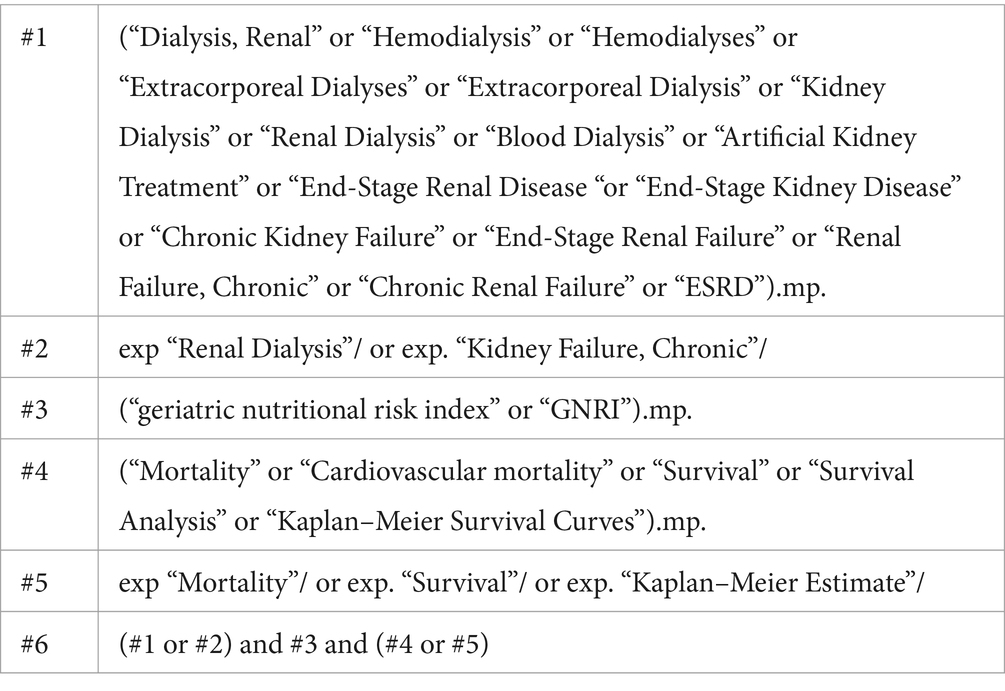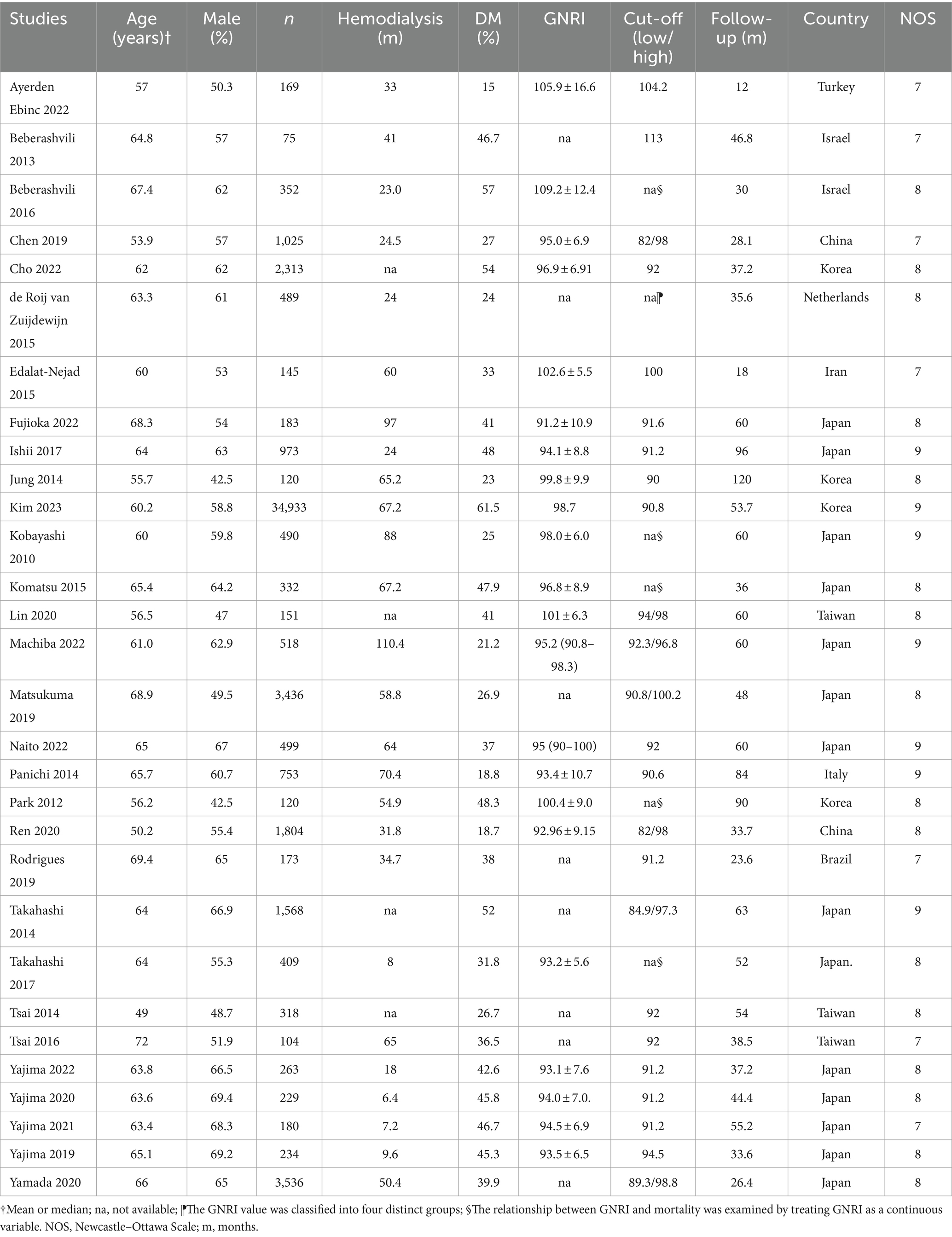- 1Department of Anesthesiology, Chi Mei Medical Center, Tainan, Taiwan
- 2Department of Anesthesiology, E-Da Hospital, I-Shou University, Kaohsiung, Taiwan
- 3Department of Psychiatry, Kaohsiung Chang Gung Memorial Hospital and Chang Gung University College of Medicine, Kaohsiung, Taiwan
- 4Department of Chinese Medicine, Chi Mei Medical Center, Tainan, Taiwan
- 5Department of Anesthesiology, Chi Mei Medical Center, Liouying, Tainan, Taiwan
Background: This meta-analysis aimed to synthesize current evidence on the association between the Geriatric Nutritional Risk Index (GNRI) and long-term outcomes in patients undergoing hemodialysis.
Methods: Electronic databases were systematically searched for relevant studies that investigated the association between GNRI and long-term outcomes in hemodialysis patients until November 2023. The primary outcome was the association between the GNRI (i.e., low versus high) and overall mortality risk, while the secondary outcome was the relationship between the GNRI and cardiovascular mortality risk.
Results: Thirty cohort studies involving 55,864 patients were included. A low GNRI was found to be significantly associated with increased overall mortality (hazard ratio [HR]: 2.42, 95% confidence interval [CIs]: 2.10–2.79, p < 0.00001, I2 = 65%). Each unit increase in GNRI corresponded to a 5% reduction in mortality risk (HR: 0.95, 95% CI: 0.93–0.96, p < 0.00001, I2 = 79%). The association remained consistent across Asian (HR = 2.45, 95% CI: 2.08–2.88, p < 0.00001, I2 = 70%) and non-Asian subgroups (HR = 2.3, 95% CI: 1.72–3.06, p < 0.00001, I2 = 23%). Meta-regression analysis of patient age (coefficient: −0.002; p = 0.896), male proportion (coefficient: 0.002; p = 0.875), percentage of diabetes mellitus (coefficient: −0.003; p = 0.605), and follow-up duration (coefficient: −0.003; p = 0.431) revealed that these moderator variables did not significantly influence the association between GNRI and overall mortality risk. Cardiovascular mortality risk also increased with low GNRI (HR, 1.93; 95%CI: 1.51–2.45, p < 0.00001; I2 = 2%). Similarly, an inverse association was observed between the GNRI values and cardiovascular mortality risk (HR, 0.94; 95% CI: 0.91–0.97; p < 0.0001; I2 = 65%) (per unit increase).
Conclusion: The GNRI is a simple nutritional screening tool that can be used to effectively stratify patients undergoing hemodialysis globally. Further studies are warranted to determine whether nutrition optimization based on the GNRI improves long-term outcomes.
Systematic review registration: https://www.crd.york.ac.uk/prospero/, CRD42023483729.
1 Introduction
End-stage renal disease (ESRD) is a global public health problem, with increasing prevalence rates worldwide in conjunction with population aging and increasing incidences of diabetes mellitus (DM), hypertension, and chronic kidney disease (1–4). The average number of new ESRD diagnoses worldwide is 144 individuals per million populations (5). However, the incidence of ESRD varies significantly across countries. In China, the estimated number of patients undergoing hemodialysis is expected to increase to 629.67 individuals per million populations in 2025 (6). Hemodialysis is the predominant form of renal replacement therapy in patients with ESRD (7). Compared with the general population, patients with ESRD undergoing hemodialysis have multiple comorbidities, impaired quality of life, malnutrition, and dramatically increased risks of cardiovascular events and premature mortality (8–10). The first-year mortality rate in elderly patients undergoing dialysis was reported to range from 30 to 54.5% (11). Protein-energy wasting is a multifaceted metabolic condition characterized by diminished mass of muscle and adipose tissue, frequently accompanied by reduced appetite and nutritional status (12). It is a common issue among patients undergoing hemodialysis, with its prevalence varying between 28 and 54% in patients undergoing regular dialysis treatment (9, 13–15). Current evidence suggests that protein energy wasting or malnutrition is a potential predictor of morbidity and mortality in this population (12, 16).
The Geriatric Nutritional Risk Index (GNRI) was developed as a simplified nutritional screening tool for assessing the risk of nutrition-related complications and nutritional status in patients undergoing maintenance hemodialysis (17–20). This tool is calculated based on serum albumin levels, body weight, and ideal body weight (18, 21). A previous meta-analysis of 10,739 patients from 19 cohort studies published between 2010 and 2018 revealed that GNRI was significantly associated with overall mortality and cardiovascular events in hemodialysis patients (22). However, the findings from the meta-analysis might not fully represent the long-term risk associated with clinical outcomes, as the associations were assessed at a single point in time—for instance, displaying results as odds ratios (ORs)—without considering the potential effects of interactions over time (22). Additional evidence is warranted to elucidate the association between the GNRI and long-term mortality risk in hemodialysis patients through time-to-event analyses. Recently, there has been a growing trend in the number of studies conducted to examine the association between the GNRI and long-term mortality risk in patients on maintenance hemodialysis, providing an opportunity to update the existing pool of knowledge (23–33). This meta-analysis aimed to synthesize the current evidence and provide a quantitative estimate of the association between GNRI and mortality risk in hemodialysis patients.
2 Materials and methods
The study protocol was registered with PROSPERO under registration number CRD42023483729, and the meta-analysis was executed in compliance with the PRISMA guidelines (34).
2.1 Data sources and search strategies
To achieve a comprehensive review of the relevant literature, we rigorously searched multiple electronic databases, including MEDLINE, Embase, Cochrane Library, and Google Scholar, to identify observational studies that investigated the association between the GNRI and long-term mortality risk in hemodialysis patients. The search period spanned from the inception of these databases until November 17, 2023. Our search strategy involved a combination of terms associated with “geriatric nutritional risk index,” “mortality,” and “hemodialysis,” and no language restrictions were imposed. In addition to electronic databases, we explored the reference lists of the included studies or relevant review articles for any additional pertinent publications. Table 1 presents a summary of the detailed search strategy for one of the databases (i.e., MEDLINE).
2.2 Study selection process
To ensure a systematic approach in selecting relevant studies, a two-step screening process was used. First, two independent reviewers screened the titles and abstracts of retrieved records to assess their potential eligibility. Second, full-text assessments of the selected records were conducted to determine final inclusion in the study. Any discrepancies or disagreements between the reviewers were promptly addressed by consulting a third reviewer, thereby ensuring uniformity and minimizing the potential for bias. The study selection adhered to a predefined protocol and specific selection criteria, ensuring transparency and replicability in the study selection process.
2.3 Inclusion and exclusion criteria
The following inclusion criteria were used for study selection: (1) studies involving adult patients undergoing maintenance hemodialysis therapy regardless of hemodialysis vintage; (2) studies assessing or reporting on the GNRI as a prognostic factor; (3) studies reporting on the association between the GNRI and time-dependent variables, including overall and cardiovascular mortality risk; and (4) cohort studies. The exclusion criteria were as follows: (1) case reports, reviews, editorials, and studies that did not provide relevant outcome data; (2) cross-sectional studies (excluded due to the lack of time-dependent variables); and (3) studies focused on patients undergoing peritoneal dialysis or those suffering from acute kidney injury.
2.4 Data collection
Relevant data were extracted independently by two team members using a standardized form, including study characteristics, participant demographics (e.g., age and male proportion), sample size, hemodialysis duration, percentage of patients with DM, GNRI cutoff values (low/high), follow-up duration, country in which the study was conducted, and mortality outcomes. For mortality outcomes, we only collected time-dependent variables (i.e., HR). In cases where information was missing, we contacted the corresponding authors of the article to request necessary details.
2.5 Outcomes and definition
The primary outcome was overall mortality, defined as death from any cause, while the secondary outcome was cardiovascular mortality. Low GNRI was the main exposure variable, as defined by the individual study. We conducted subgroup analyses to explore the impact of the geographical location of the study populations (i.e., Asian and non-Asian) on the primary outcome.
2.6 Quality assessment of included studies
The quality of the included studies was assessed using the Newcastle–Ottawa Scale, which consists of three main components: selection, comparability, and outcome of interest. Studies were awarded stars in each category, with more stars indicating a higher quality. Each study was awarded a maximum of nine stars, with studies receiving six or more stars deemed high quality. This threshold was set to distinguish studies with a lower risk of bias and robust methodological approach. Disagreements were resolved by consensus or consultation with a third reviewer.
2.7 Statistical analysis
Statistical analyses were conducted using Comprehensive Meta-Analysis software (Version 4, Biostat, Englewood, NJ). Owing to the anticipated clinical and methodological heterogeneity among the included studies, a random-effects model was used. Heterogeneity among studies was quantified using the I2 statistic, which describes the percentage of total variation across studies caused by heterogeneity rather than by chance. An I2 value exceeding 50% indicated considerable heterogeneity among studies. Sensitivity analyses were conducted to evaluate the impact of each study on combined effect size. Furthermore, funnel plots were created to assess publication bias for outcomes reported in more than 10 studies. A meta-regression analysis was conducted to explore the potential sources of heterogeneity and assess the impact of the moderator variables on the effect size. The variables included age, male proportion, percentage of patients with DM, and follow-up duration. These variables were selected based on their clinical relevance and likelihood of influencing the association between the GNRI and long-term mortality. The statistical significance of the pooled estimates and meta-regression coefficients was set at p < 0.05.
3 Results
3.1 Study selection and characteristics of studies
The selection process for the meta-analysis is illustrated in Figure 1. Database searches, including PubMed, Embase, Cochrane Library, and Google Scholar, initially yielded 403 records. After removing 80 duplicates and 362 records based on titles and abstracts, 41 records were retrieved for full-text review. All of these were assessed for eligibility, and various reports were excluded for reasons such as review articles or irrelevant to the study population. Ultimately, 30 studies were deemed suitable and included in the meta-analysis (23–33, 35–53).
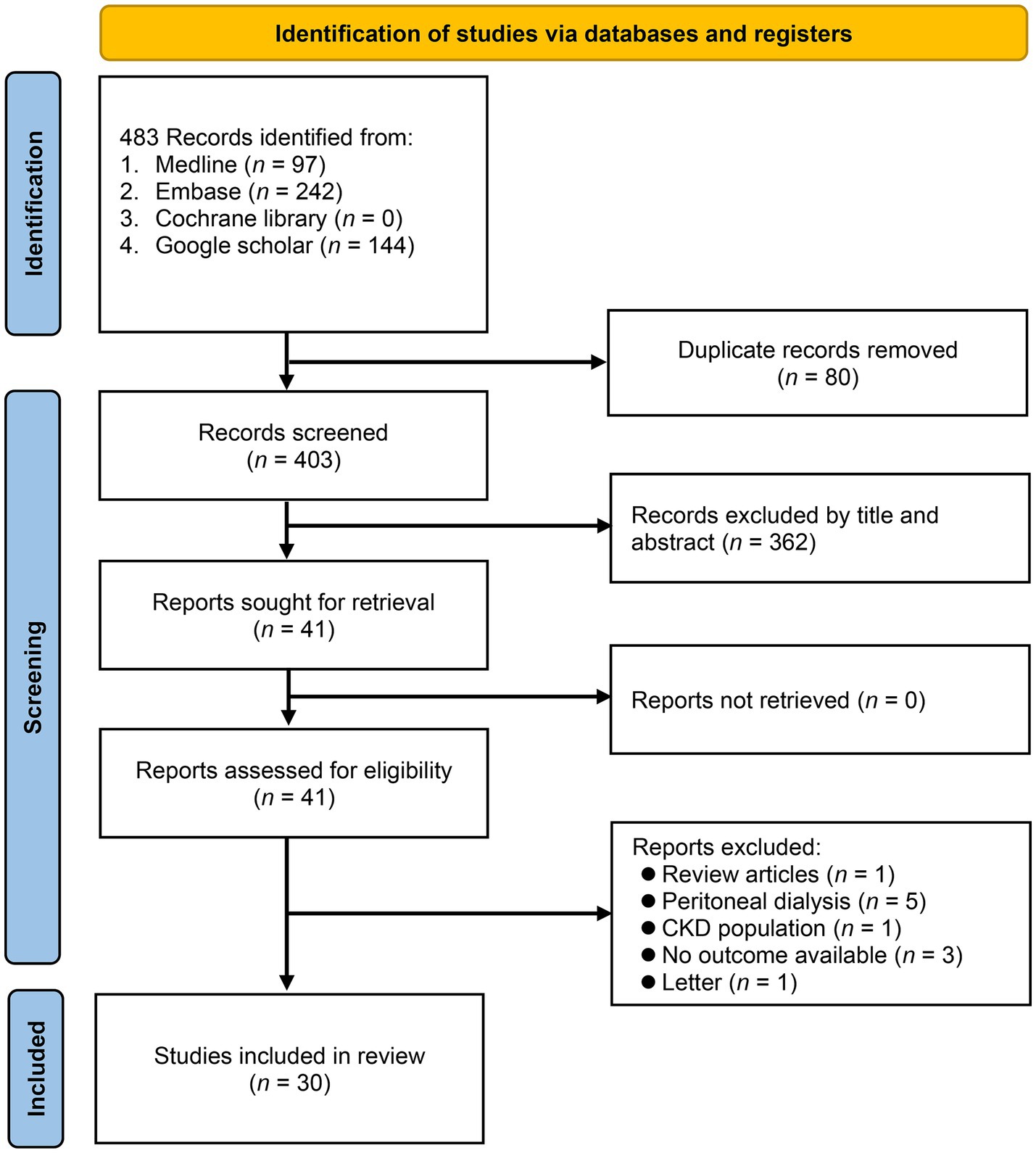
Figure 1. The flowchart outlining the study selection process for current meta-analysis. CKD, chronic kidney disease.
Table 2 presents data from 30 studies published between 2010 and 2023 that examined the association between GNRI and mortality in hemodialysis patients. These studies were conducted globally across countries, including Turkey, Japan, Korea, China, Taiwan, Israel, Italy, the Netherlands, Iran, and Brazil. The mean or median age of the patients ranged from 49 to 72 years, with the percentage of males ranging from 42.5 to 69.4%. The sample sizes varied significantly across studies, with a minimum of 75 patients and a maximum of 34,933 patients, accumulating in a combined total of 55,864 patients. The hemodialysis vintage varied from 6.4 to 110.4 months in 26 studies, while four studies did not provide relevant information. The percentage of patients with DM as a comorbidity ranged from 15 to 61.5%. The mean GNRI scores ranged from 91.2 to 109.2. The follow-up period for mortality analysis ranged from 12 to 120 months. All 30 studies assessed in the analysis were considered to be of high quality with a low risk of bias, as each scored seven or higher on the Newcastle–Ottawa Scale.
3.2 Outcomes
3.2.1 Primary outcomes
Of the 30 included studies, 25 provided categorical GNRI data (low versus high GNRI groups), allowing them to be pooled for the primary meta-analysis. The other five studies only provided continuous GNRI data and did not have categorical cutoff values. These five studies were not excluded, as we utilized them in a separate analysis to examine the impact of the GNRI on mortality risk when treating the GNRI as a continuous variable.
In our meta-analysis on 25 studies, we found a significant association between lower GNRI and increased long-term mortality risk, with a combined HR of 2.42 (95% CI, 2.10–2.79, p < 0.00001), indicating a more-than-twofold-higher risk of mortality (Figure 2) (23–33, 35, 36, 38–42, 45, 46, 48, 50–53). Sensitivity analysis revealed that this association was evident across multiple studies despite moderate to high heterogeneity (I2 = 65%), reinforcing the value of the GNRI as a prognostic indicator for this patient population. Additional analysis revealed that with each unit increase in GNRI, there was a corresponding decrease in the overall mortality risk (HR: 0.95, 95% CI: 0.93–0.96, p < 0.00001, I2 = 79%), suggesting an inverse association (Figure 3) (23–25, 27, 28, 32, 35–37, 43, 44, 47, 49, 52, 53). The funnel plot shows a largely symmetrical spread of studies around the combined effect estimate, suggesting minimal publication bias (Figure 4) (23–33, 35, 36, 38–42, 45, 46, 48, 50–53).
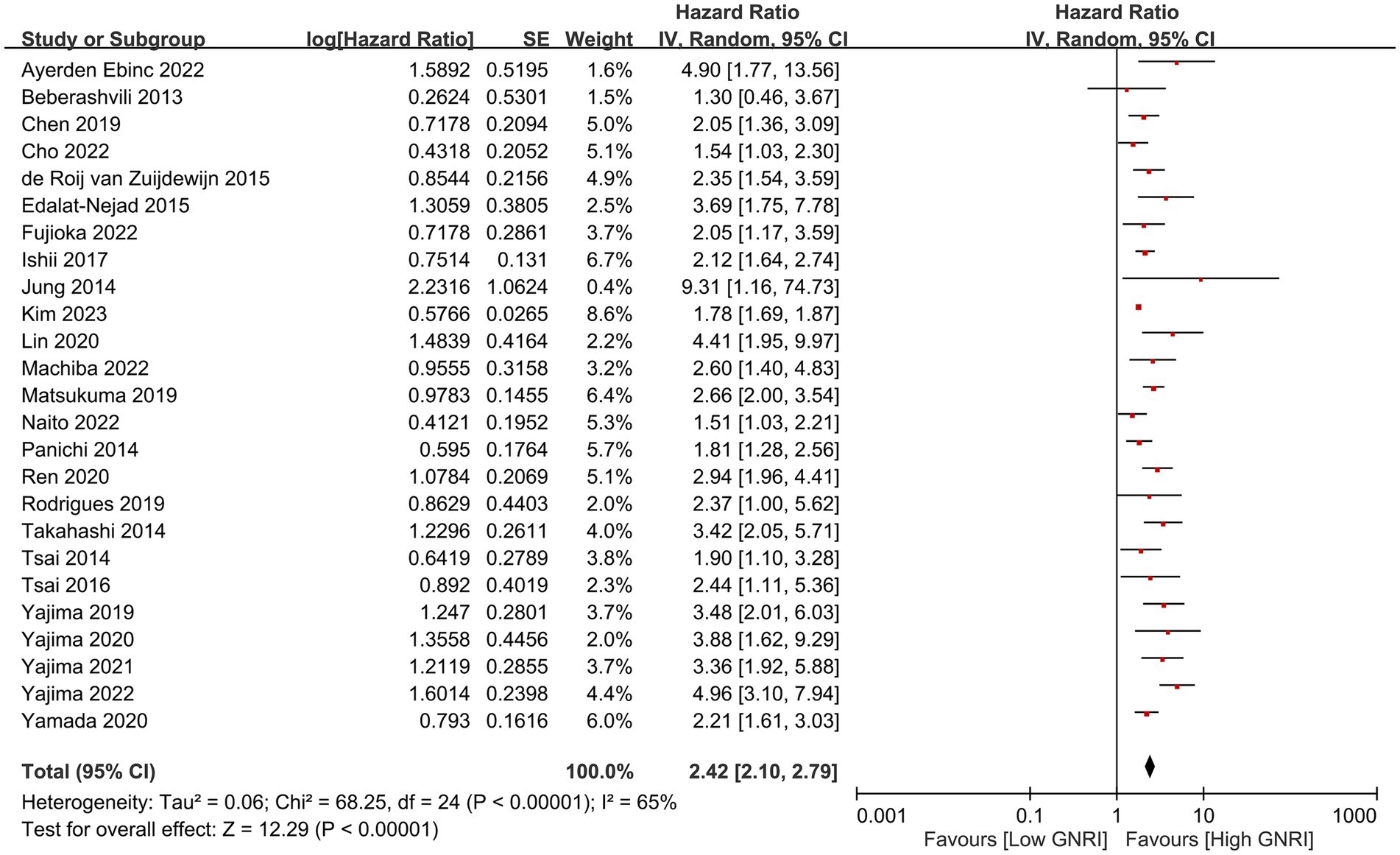
Figure 2. Forest plot showing the association between the Geriatric Nutritional Risk Index (GNRI) and overall mortality. CI, confidence intervals.
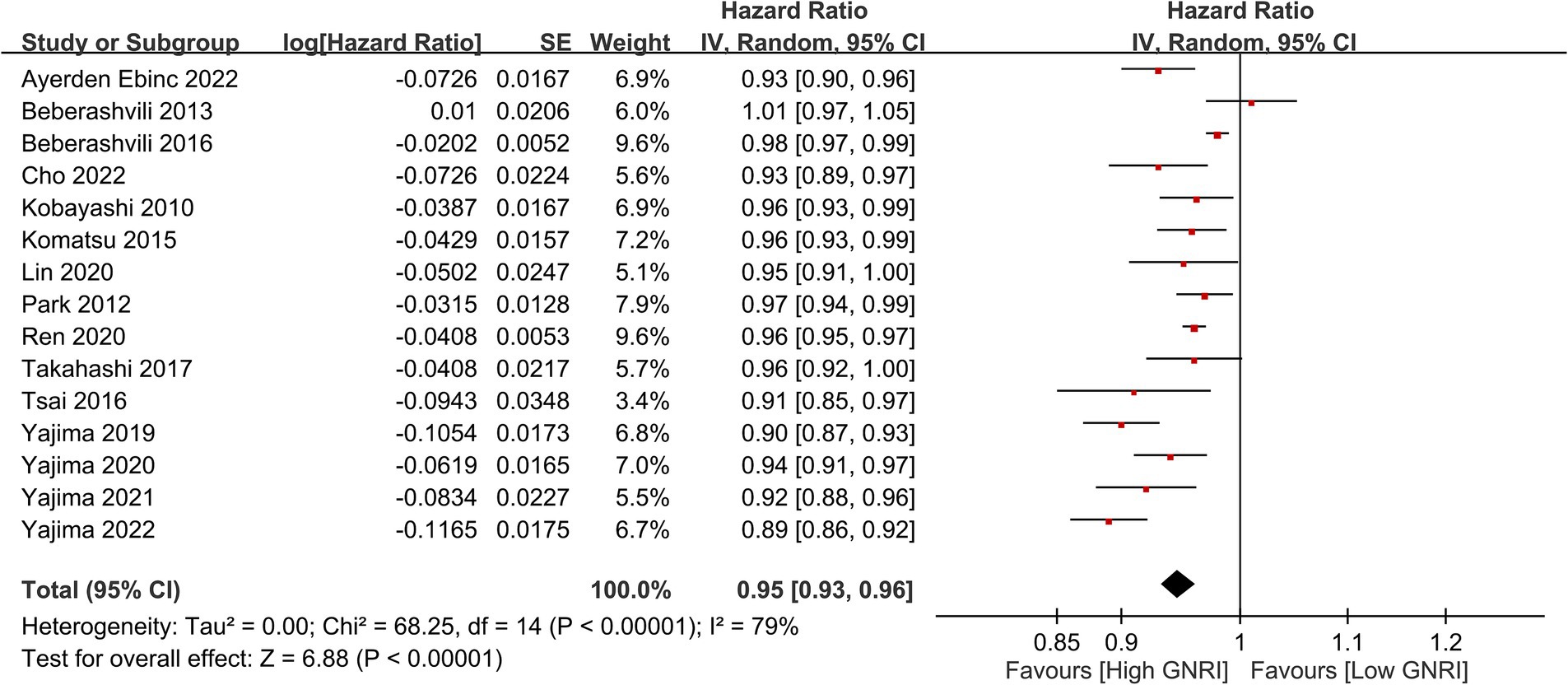
Figure 3. Forest plot showing that with each unit increase in Geriatric Nutritional Risk Index (GNRI), there was a corresponding decrease in overall mortality risk. CI, confidence intervals.
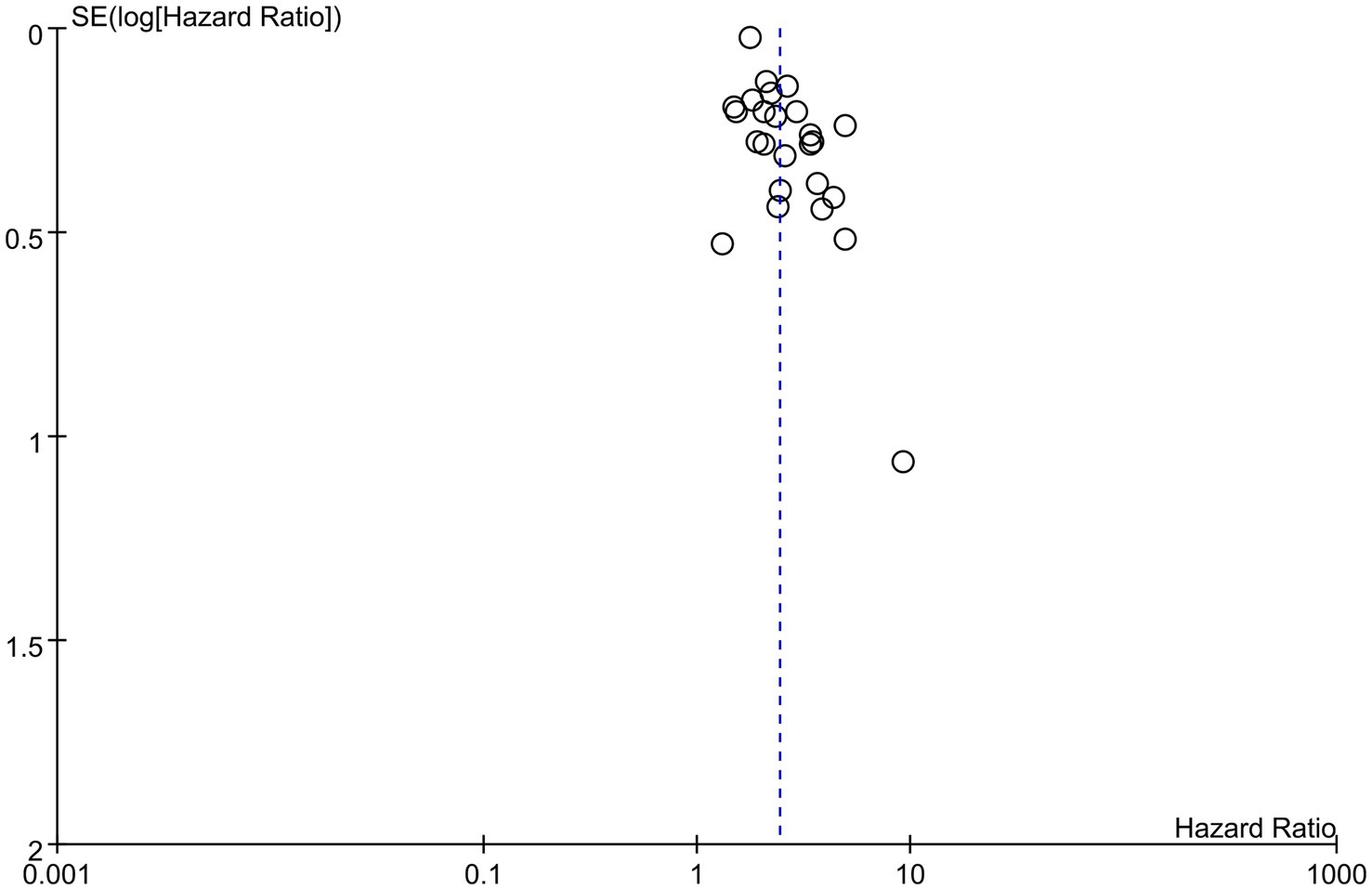
Figure 4. Funnel plot showing the publication bias in studies examining the association between the geriatric nutritional risk index (GNRI) and overall mortality.
Subgroup analyses revealed a significant association between lower GNRI and increased overall mortality risk (HR = 2.3, 95% CI: 1.72–3.06, p < 0.00001, I2 = 23%) in non-Asian population (Figure 5) (23–33, 35, 36, 38–42, 45, 46, 48, 50–53). For Asian studies, this association was also significant and slightly stronger (HR = 2.45, 95% CI: 2.08–2.88, p < 0.00001), albeit with substantial heterogeneity (I2 = 70%) (Figure 5) (23–33, 35, 36, 38–42, 45, 46, 48, 50–53). This finding suggests that the GNRI is a consistent predictor of mortality across different ethnic populations.
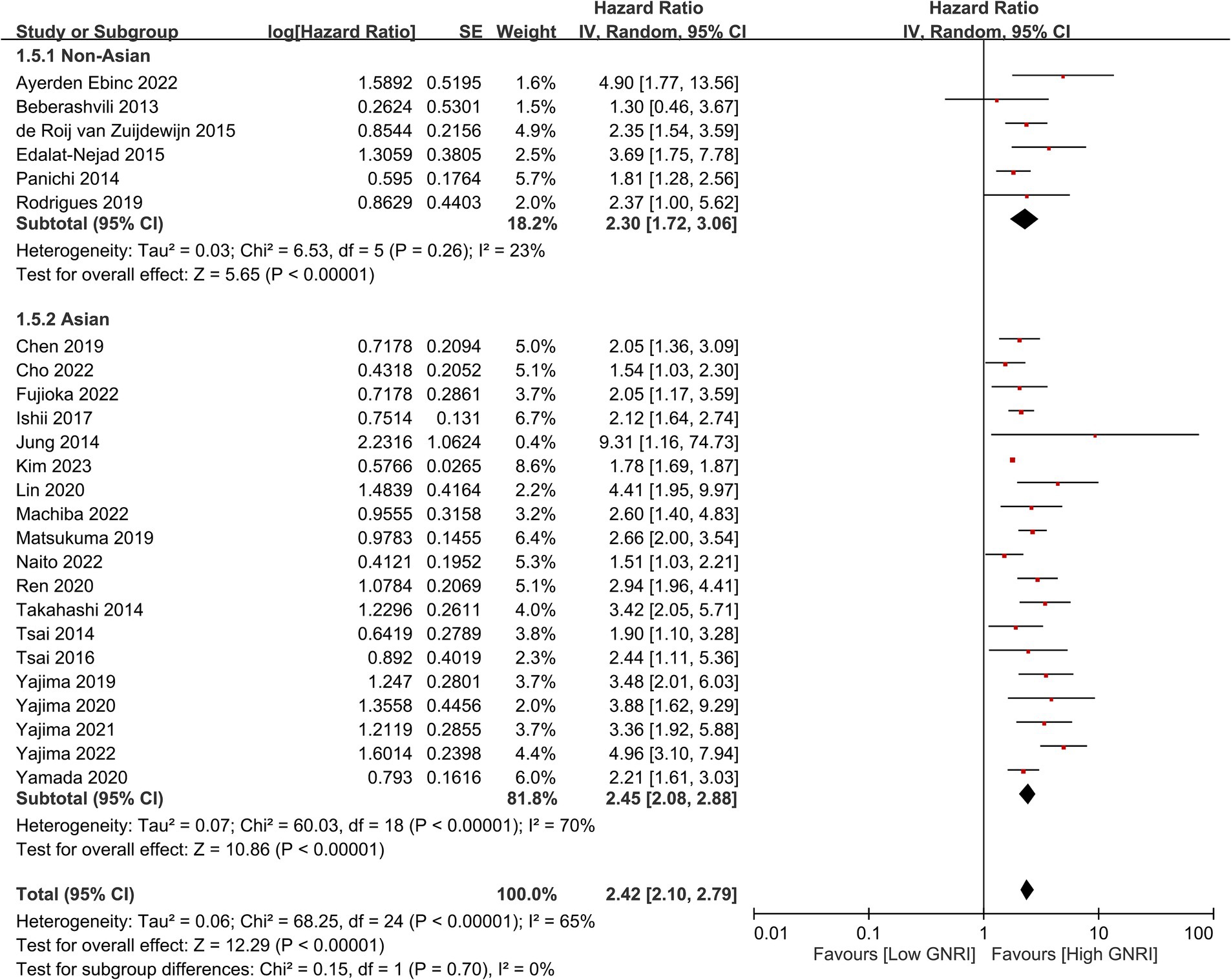
Figure 5. Subgroup analysis showing the association between the geriatric nutritional risk index (GNRI) and overall mortality across different ethnic populations. CI, confidence intervals.
Meta-regression analysis of patient age (coefficient: −0.002; p = 0.896) (Figure 6) (23–33, 35, 36, 38–42, 45, 46, 48, 50–53), male proportion (coefficient: 0.002; p = 0.875) (Figure 7) (23–33, 35, 36, 38–42, 45, 46, 48, 50–53), percentage of patients with DM (coefficient: −0.003; p = 0.605) (Figure 8) (23–33, 35, 36, 38–42, 45, 46, 48, 50–53), and follow-up duration (coefficient: −0.003; p = 0.431) (Figure 9) (23–33, 35, 36, 38–42, 45, 46, 48, 50–53) revealed that these moderator variables did not significantly impact the association between GNRI and mortality outcomes.
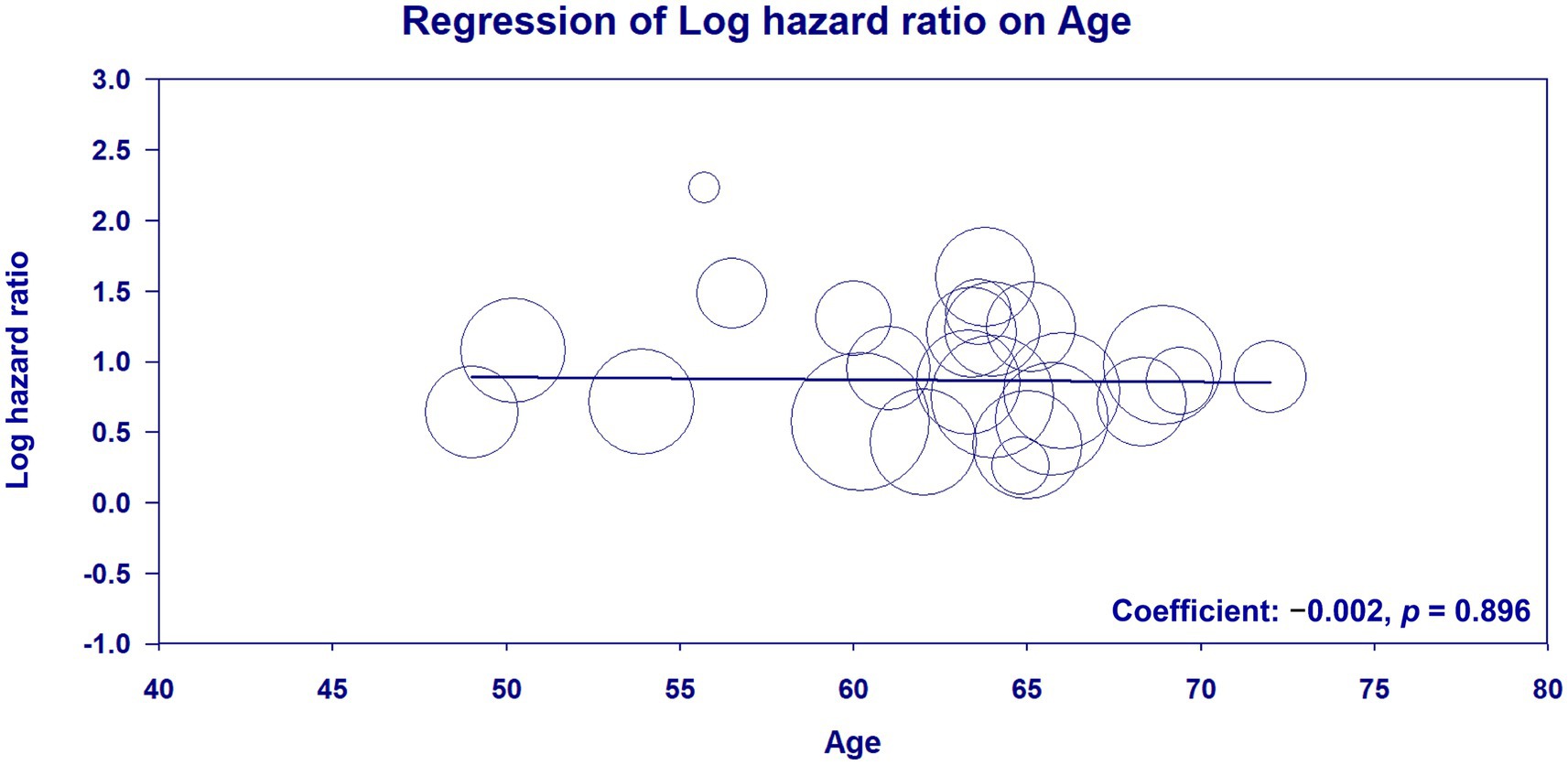
Figure 6. Meta-regression plot analyzing the impact of the age on the effect size on the association between the geriatric nutritional risk index (GNRI) and overall mortality.
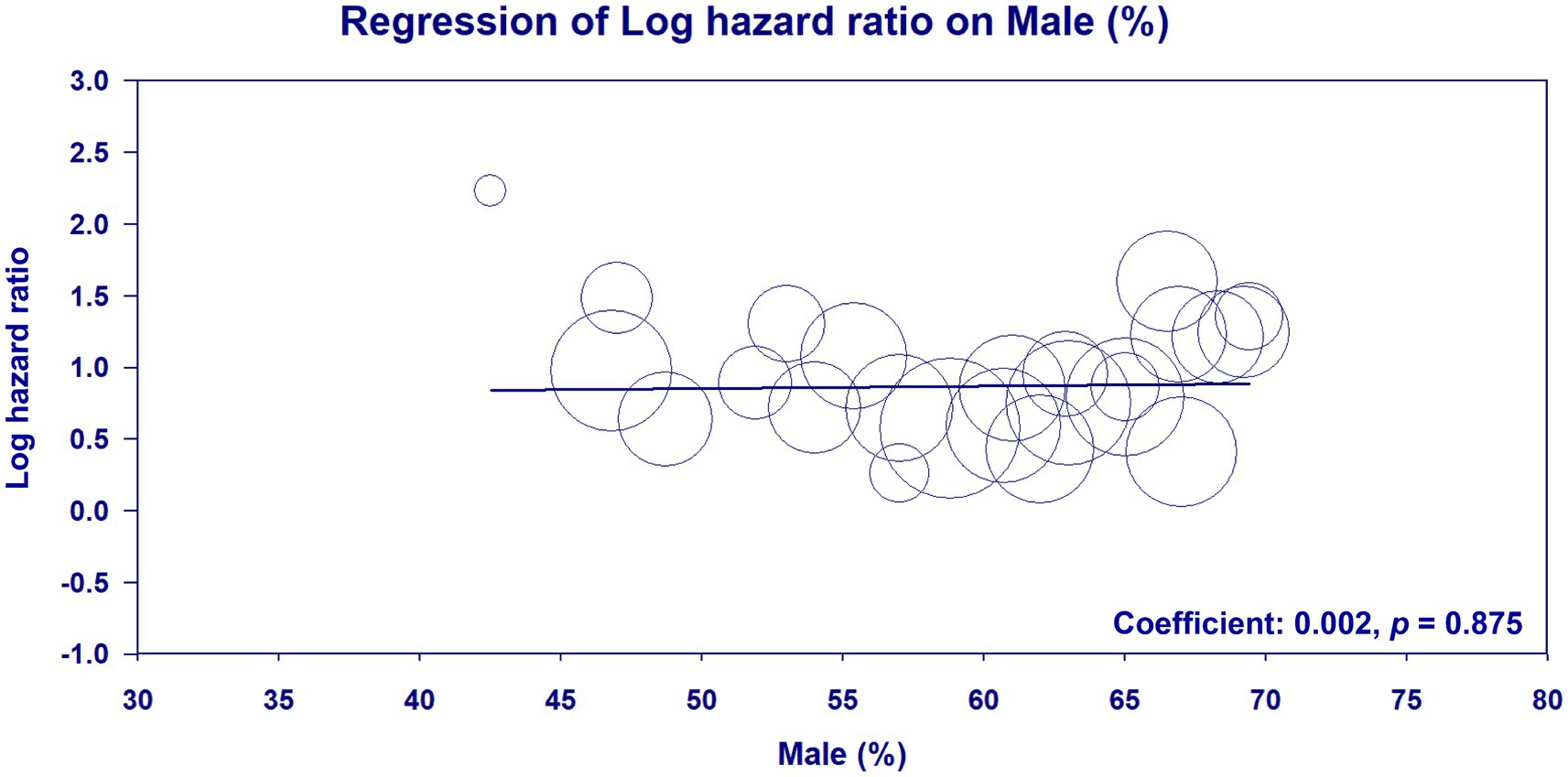
Figure 7. Meta-regression plot analyzing the impact of the male proportion on the effect size of the association between the geriatric nutritional risk index (GNRI) and overall mortality.
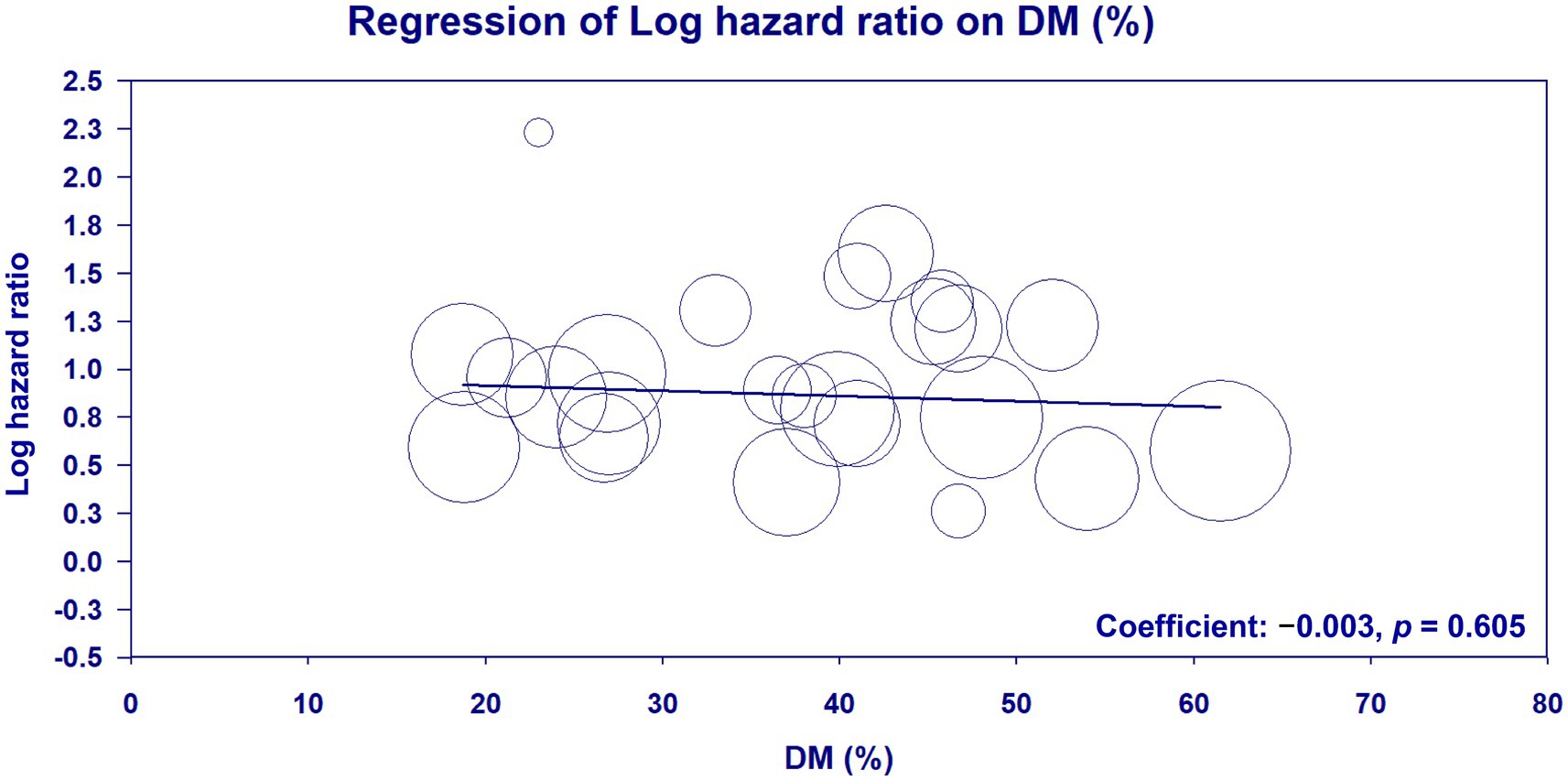
Figure 8. Meta-regression plot analyzing the impact of percentage of patients with diabetes mellitus (DM) on the effect size on the association between the geriatric nutritional risk index (GNRI) and overall mortality.

Figure 9. Meta-regression plot analyzing the impact of follow-up duration on the effect size on the association between the geriatric nutritional risk index (GNRI) and overall mortality.
3.2.2 Secondary outcomes
Meta-analysis on cardiovascular mortality among hemodialysis patients revealed a significant association between lower GNRI scores and increased cardiovascular mortality risk, with a combined HR of 1.93 (95% CI, 1.51–2.45, p < 0.00001, I2 = 2%) (Figure 10) (25–27, 35, 41, 51, 53). The sensitivity analysis revealed a consistent finding using the leave-one-out approach. Similarly, an inverse association was observed between GNRI values and cardiovascular mortality risk (HR: 0.94, 95% CI: 0.91–0.97, p < 0.0001, I2 = 65%) (per unit increase) (Figure 11) (25, 27, 35, 37, 44, 53).

Figure 10. Forest plot illustrating the association between the geriatric nutritional risk index (GNRI) and cardiovascular mortality. CI, confidence intervals.

Figure 11. Forest plot showing that with each unit increase in Geriatric Nutritional Risk Index (GNRI), there was a corresponding decrease in cardiovascular mortality risk. CI, confidence intervals.
4 Discussion
Assessment of the prognostic value of the GNRI can facilitate evidence-based practices to optimize the delivery of nutritional interventions and improve risk stratification for targeted care in high-risk hemodialysis populations. In the meta-analysis of 30 studies involving a total of 55,864 patients, a notable correlation was observed between a lower GNRI and an increase in overall mortality risk (HR: 2.42). Furthermore, it was found that each increment in GNRI corresponded with a reduced overall mortality risk (HR: 0.95). The funnel plot showed negligible publication bias. Subgroup analyses have revealed that the GNRI consistently predicts overall mortality risk across diverse ethnic groups. In addition, meta-regression analyses revealed that variables such as patient age, male proportion, percentage of patients with DM, and follow-up duration did not significantly affect the association between the GNRI and overall mortality risk. In relation to cardiovascular mortality among hemodialysis patients, a significant association was observed between lower GNRI scores and an increased risk (HR: 1.93). Similarly, it was found that each increment in GNRI corresponded with reduced cardiovascular mortality risk (HR: 0.94).
Our findings indicate a significant association between lower GNRI scores and increased overall mortality risk. Having a simple and objective tool for identifying patients at a greater risk of mortality based on their nutritional status is of great clinical value for the following reasons. First, earlier nutritional interventions in patients on hemodialysis may improve outcomes (54, 55). The use of the GNRI as a screening tool may help effectively identify these high-risk patients and enable the implementation of preventive strategies. Second, the association between the GNRI and overall mortality risk contributes to better-informed discussions with patients regarding their expected health outcomes. However, the analyzed studies were observational; therefore, causal conclusions cannot be drawn regarding the effect of nutritional status improvements on mortality. Nevertheless, the consistency of the association, despite the population differences, supports the reliability of the findings. Overall, this meta-analysis provides robust evidence that the GNRI could be a practical nutritional assessment tool that can be incorporated into the care of hemodialysis patients globally to identify those with a higher mortality risk. Additional studies are warranted to determine the effects of nutritional support guided by GNRI scores on patient-centered outcomes.
An important strength of this meta-analysis was the inclusion of data solely from patients undergoing hemodialysis. Patients receiving other forms of dialysis such as peritoneal dialysis were excluded. Combining data across different dialysis modalities could potentially impact mortality outcomes (56) and limit the generalizability of the findings to specific populations. By focusing our meta-analysis specifically on patients receiving hemodialysis, we were able to evaluate the GNRI-mortality association in a distinct patient group with shared characteristics. Compared with a previous meta-analysis of 19 studies involving 10,739 patients (22), the present analysis significantly expands the evidence base, encompassing 30 studies with a cumulative total of 55,864 patients. The increase in sample size enhanced the statistical robustness and confidence in the outcomes. Furthermore, our analysis benefits from the incorporation of studies published within a more contemporary window from 2010 to 2023, providing insights from data collected over the last decade, whereas the previous analysis included studies published up to 2018 (22). Analytically, our meta-analysis advances by using time-to-event data such as HRs, which are more indicative of longitudinal trends in patient health, as opposed to the single point ORs previously used (22). Finally, the robustness of our research findings is bolstered by the thorough methodology used, including meta-regression and subgroup analysis, which adds to the overall strength of our results.
Compared with other clinical predictors, the GNRI may serve as a stronger prognostic factor. A previous meta-analysis of 28 studies revealed that geriatric impairments such as functional and cognitive decline, as well as falls, were associated with a higher mortality risk in elderly dialysis patients (OR: 1.14–1.45), in addition to traditional factors such as age and comorbidities (57). A review of nine cohort studies demonstrated that low handgrip strength was significantly associated with an increased mortality risk in dialysis patients (risk ratio [RR]: 1.88) (58). Furthermore, a meta-analysis of eight observational studies involving 190,163 patients revealed a paradoxical association between low body mass index and a higher mortality risk (RR: 1.22) in dialysis patients (59). Another meta-analysis of 38 studies highlighted serum albumin as having a strong inverse association with mortality in patients on dialysis (HR: 0.7038) (60). Our finding that a lower GNRI is associated with increased overall mortality risk, as indicated by a combined HR of 2.42, highlights the utility of this predictor in clinical settings.
The efficacy of the GNRI in predicting overall mortality may vary across populations. For the general population, a previous meta-analysis of 26 observational studies involving 17,097 participants revealed a significant association between low GNRI and an increased risk of both all-cause (HR: 1.32) and cardiovascular (HR: 2.10) mortalities (61). For elderly patients with heart failure, a meta-analysis of nine studies involving 7,659 patients revealed that low GNRI was predictive of all-cause mortality (HR: 1.56) compared to high GNRI (62). In addition, low GNRI values have been associated with an increased overall mortality risk in patients with head and neck, gastrointestinal, or lung cancer, with HRs ranging from 2.39 2.84 (63–65). Considering our findings and previous research, it appears that using the GNRI as a prognostic tool in patients on hemodialysis or suffering from cancer is more beneficial than in other clinical situations.
Despite the focus of our meta-analysis on studies predominantly from Asian countries, there is evidence that the use of nutritional indices to predict long-term outcomes is equally feasible and effective in non-Asian populations. A recent study that examined 101,616 hemodialysis patients in the United States found that higher Prognostic Nutritional Index (PNI) quartiles were associated with stepwise reductions in all-cause mortality (66). For instance, compared with the lowest PNI quartiles, patients in the highest quartile had a 64% lower mortality (66). Furthermore, a higher PNI predicted mortality better than albumin or lymphocyte count alone (66). A key distinction between the GNRI and PNI is that the former relies on serum albumin, body weight, and ideal weight, whereas the latter incorporates albumin and lymphocyte count. Although both use distinct formulations, recent research (66) and our meta-analysis have demonstrated that nutritional indices are effective in predicting the clinical outcomes of hemodialysis patients regardless of their ethnicity. Compared to the PNI, the simplicity of the GNRI, owing to its exclusion of cell counts, makes it a practical and valuable tool in clinical settings.
This meta-analysis had several limitations that need to be acknowledged. First, all the included studies were observational in nature, which prevented the determination of causal associations between the GNRI and mortality outcomes. Residual confounding factors may still be present despite adjustments made in the analyses of individual studies. Second, there was moderate to substantial heterogeneity among the studies for the primary outcome, indicating variability in effects and populations. We addressed this by using a random-effects model and conducting meta-regression; however, some heterogeneity was likely due to differences in the study design and patient factors that could not be accounted for. Potential sources of heterogeneity include differences in patient characteristics, such as comorbidities and dialysis vintages, variation in ethnicities and healthcare systems across countries, and lack of standardized cut-off values used for categorizing high and low GNRI groups. Third, the majority of studies were conducted in Asian countries, with relatively few focusing on Western populations. Additional research may be warranted to confirm the generalizability of these findings to diverse ethnic groups globally. Finally, publication bias is a concern in meta-analyses, although we did not find evidence of significant bias based on visual inspection of funnel plots. However, studies with small sample sizes and null findings may be underrepresented. Overall, this meta-analysis provides strong evidence for the utility of the GNRI as a prognostic marker in hemodialysis patients; however, the limitations highlight the need for cautious interpretation and further high-quality longitudinal studies.
5 Conclusion
This meta-analysis of 30 studies involving 55,864 patients revealed an inverse association of the GNRI with overall and cardiovascular mortalities, highlighting the potential of the GNRI as a predictor of patient outcomes. Consistent findings across ethnicities and the lack of influence of age, sex, DM, and follow-up duration on this association highlight the reliability of the GNRI as a prognostic tool. These results underscore the importance of nutritional assessment in patient care and advocate for future research to explore the GNRI as a guide for nutritional interventions to enhance patient survival.
Data availability statement
The original contributions presented in the study are included in the article/supplementary material, further inquiries can be directed to the corresponding author.
Author contributions
K-CH: Conceptualization, Data curation, Formal analysis, Writing – original draft, Writing – review & editing. C-LK: Conceptualization, Data curation, Writing – original draft, Writing – review & editing. C-WH: Investigation, Methodology, Resources, Writing – original draft, Writing – review & editing. C-HY: Methodology, Software, Writing – original draft, Writing – review & editing. C-ML: Methodology, Writing – original draft, Writing – review & editing. H-TC: Conceptualization, Methodology, Writing – original draft, Writing – review & editing. Y-JC: Methodology, Writing – original draft, Writing – review & editing. S-WL: Investigation, Methodology, Writing – original draft, Writing – review & editing. I-WC: Conceptualization, Data curation, Formal analysis, Methodology, Writing – original draft, Writing – review & editing.
Funding
The author(s) declare that no financial support was received for the research, authorship, and/or publication of this article.
Conflict of interest
The authors declare that the research was conducted in the absence of any commercial or financial relationships that could be construed as a potential conflict of interest.
Publisher’s note
All claims expressed in this article are solely those of the authors and do not necessarily represent those of their affiliated organizations, or those of the publisher, the editors and the reviewers. Any product that may be evaluated in this article, or claim that may be made by its manufacturer, is not guaranteed or endorsed by the publisher.
References
1. Sanyaolu, A, Okorie, C, Annan, R, Turkey, H, Akhtar, N, Gray, F, et al. Epidemiology and management of chronic renal failure: a global public health problem. Biostat Epidemiol Int J. (2018) 1:11–6. doi: 10.30881/beij.00005
2. Lv, J-C, and Zhang, L-X. Prevalence and disease burden of chronic kidney disease. Adv Exp Med Biol. (2019) 1165:3–15. doi: 10.1007/978-981-13-8871-2_1
3. Thurlow, JS, Joshi, M, Yan, G, Norris, KC, Agodoa, LY, Yuan, CM, et al. Global epidemiology of end-stage kidney disease and disparities in kidney replacement therapy. Am J Nephrol. (2021) 52:98–107. doi: 10.1159/000514550
4. Liu, W, Zhang, D, Wang, R, Chen, J, Zhang, J, Tao, D, et al. Global trends in the burden of chronic kidney disease attributable to type 2 diabetes: An age-period-cohort analysis. Diabetes Obes Metab. (2023) 26:602–10. doi: 10.1111/dom.15349
5. Lee, S, Supparamaniam, S, Varghese, C, and Mahawar, K. Marginal ulcers following one-anastomosis gastric bypass: a systematic review and Meta-analysis. Obes Surg. (2023) 33:2884–97. doi: 10.1007/s11695-023-06762-5
6. Yang, C, Yang, Z, Wang, J, Wang, HY, Su, Z, Chen, R, et al. Estimation of prevalence of kidney disease treated with Dialysis in China: a study of insurance claims data. Am J Kidney Dis. (2021) 77:889–97.e1. doi: 10.1053/j.ajkd.2020.11.021
7. Liew, A. Perspectives in renal replacement therapy: Haemodialysis. Nephrology (Carlton). (2018) 23:95–9. doi: 10.1111/nep.13449
8. Canaud, B, Kooman, JP, Selby, NM, Taal, MW, Francis, S, Maierhofer, A, et al. Dialysis-induced cardiovascular and multiorgan morbidity. Kidney Int Rep. (2020) 5:1856–69. doi: 10.1016/j.ekir.2020.08.031
9. Ghorbani, A, Hayati, F, Karandish, M, and Sabzali, S. The prevalence of malnutrition in hemodialysis patients. Journal of renal. Inj Prev. (2020) 9:e15. doi: 10.34172/jrip.2020.15
10. Hiramatsu, T, Okumura, S, Asano, Y, Mabuchi, M, Iguchi, D, and Furuta, S. Quality of life and emotional distress in peritoneal dialysis and hemodialysis patients. Ther Apher Dial. (2020) 24:366–72. doi: 10.1111/1744-9987.13450
11. Wachterman, MW, O’Hare, AM, Rahman, O-K, Lorenz, KA, Marcantonio, ER, Alicante, GK, et al. One-year mortality after Dialysis initiation among older adults. JAMA Intern Med. (2019) 179:987–90. doi: 10.1001/jamainternmed.2019.0125
12. Oliveira, EA, Zheng, R, Carter, CE, and Mak, RH. Cachexia/protein energy wasting syndrome in CKD: causation and treatment. Semin Dial. (2019) 32:493–9. doi: 10.1111/sdi.12832
13. Koppe, L, Fouque, D, and Kalantar-Zadeh, K. Kidney cachexia or protein-energy wasting in chronic kidney disease: facts and numbers. J Cachexia Sarcopenia Muscle. (2019) 10:479–84. doi: 10.1002/jcsm.12421
14. Windahl, K, Faxén Irving, G, Almquist, T, Lidén, MK, van de Luijtgaarden, M, Chesnaye, NC, et al. Prevalence and risk of protein-energy wasting assessed by subjective global assessment in older adults with advanced chronic kidney disease: results from the EQUAL study. J Renal Nutr. (2018) 28:165–74. doi: 10.1053/j.jrn.2017.11.002
15. Carrero, JJ, Thomas, F, Nagy, K, Arogundade, F, Avesani, CM, Chan, M, et al. Global prevalence of protein-energy wasting in kidney disease: a Meta-analysis of contemporary observational studies from the International Society of Renal Nutrition and Metabolism. J Renal Nutr. (2018) 28:380–92. doi: 10.1053/j.jrn.2018.08.006
16. Toyoda, K, Kuragano, T, Kawada, H, Taniguchi, T, and Nakanishi, T. Effect of progression in malnutrition and inflammatory conditions on adverse events and mortality in patients on maintenance hemodialysis. Blood Purif. (2019) 47:3–11. doi: 10.1159/000496629
17. Yamada, K, Furuya, R, Takita, T, Maruyama, Y, Yamaguchi, Y, Ohkawa, S, et al. Simplified nutritional screening tools for patients on maintenance hemodialysis. Am J Clin Nutr. (2008) 87:106–13. doi: 10.1093/ajcn/87.1.106
18. Bouillanne, O, Morineau, G, Dupont, C, Coulombel, I, Vincent, JP, Nicolis, I, et al. Geriatric nutritional risk index: a new index for evaluating at-risk elderly medical patients. Am J Clin Nutr. (2005) 82:777–83. doi: 10.1093/ajcn/82.4.777
19. Li, H, Cen, K, Sun, W, and Feng, B. Prognostic value of geriatric nutritional risk index in elderly patients with heart failure: a meta-analysis. Aging Clin Exp Res. (2021) 33:1477–86. doi: 10.1007/s40520-020-01656-3
20. Jia, Z, El Moheb, M, Nordestgaard, A, Lee, JM, Meier, K, Kongkaewpaisan, N, et al. The geriatric nutritional risk index is a powerful predictor of adverse outcome in the elderly emergency surgery patient. J Trauma Acute Care Surg. (2020) 89:397–404. doi: 10.1097/TA.0000000000002741
21. Cereda, E, and Pedrolli, C. The geriatric nutritional risk index. Curr Opin Clin Nutr Metab Care. (2009) 12:1–7. doi: 10.1097/MCO.0b013e3283186f59
22. Xiong, J, Wang, M, Zhang, Y, Nie, L, He, T, Wang, Y, et al. Association of Geriatric Nutritional Risk Index with mortality in hemodialysis patients: a Meta-analysis of cohort studies. Kidney Blood Press Res. (2018) 43:1878–89. doi: 10.1159/000495999
23. Lin, J-H, Chang, H-R, Tsai, J-P, Wu, S-W, Tsai, P-Y, Lian, J-D, et al. Geriatric nutritional risk index is a non-inferior prognostic marker compared to albumin in hemodialysis patients: a 5-year cohort study. Acta Nephrol. (2020) 34:34–44. doi: 10.6221/AN.202003_34(1).0005
24. Ren, M, Sheng, Q, Xie, X, Zhang, X, Han, F, and Chen, J. Geriatric nutritional risk index is associated with mortality in peritoneal dialysis patients. Intern Med J. (2020) 50:470–6. doi: 10.1111/imj.14680
25. Yajima, T, Yajima, K, and Takahashi, H. Impact of annual change in geriatric nutritional risk index on mortality in patients undergoing hemodialysis. Nutrients. (2020) 12:3333. doi: 10.3390/nu12113333
26. Yamada, S, Yamamoto, S, Fukuma, S, Nakano, T, Tsuruya, K, and Inaba, M. Geriatric nutritional risk index (GNRI) and creatinine index equally predict the risk of mortality in hemodialysis patients: J-DOPPS. Sci Rep. (2020) 10:5756. doi: 10.1038/s41598-020-62720-6
27. Yajima, T, Yajima, K, and Takahashi, H. Association of the erythropoiesis-stimulating agent resistance index and the geriatric nutritional risk index with cardiovascular mortality in maintenance hemodialysis patients. PLoS One. (2021) 16:e0245625. doi: 10.1371/journal.pone.0245625
28. Cho, A, Park, SY, Cha, YS, Park, HC, Kim, DH, and Lee, Y-K. The change in geriatric nutritional risk index is associated with mortality in patients who start hemodialysis: Korean renal data registry, 2016–2018. Sci Rep. (2022) 12:20352. doi: 10.1038/s41598-022-24981-1
29. Fujioka, H, Koike, T, Imamura, T, Tomoda, F, Kakeshita, K, Yamazaki, H, et al. Impact of geriatric nutritional risk index and modified creatinine index combination on mortality in hemodialysis patients. Nutrients. (2022) 14:801. doi: 10.3390/nu14040801
30. Machiba, Y, Mori, K, Shoji, T, Nagata, Y, Uedono, H, Nakatani, S, et al. Nutritional disorder evaluated by the geriatric nutritional risk index predicts death after hospitalization for infection in patients undergoing maintenance hemodialysis. J Ren Nutr. (2022) 32:751–7. doi: 10.1053/j.jrn.2022.01.008
31. Naito, T, Doi, T, Morii, K, Usui, K, Arita, M, Yamashita, K, et al. Synergistic effects of the geriatric nutritional risk index and the modified creatinine index for predicting mortality in patients on hemodialysis. Nutrients. (2022) 14:2398. doi: 10.3390/nu14122398
32. Yajima, T, Yajima, K, and Arao, M. Combined evaluation of geriatric nutritional risk index and modified creatinine index for predicting mortality in patients on hemodialysis. Nutrients. (2022) 14:752. doi: 10.3390/nu14040752
33. Kim, DH, Lee, Y-K, Park, HC, Kim, BY, Lee, M, Kim, GO, et al. The geriatric nutritional risk index is an optimal evaluation parameter for predicting mortality in adult all ages hemodialysis patients: a Korean population-based study. Nutrients. (2023) 15:3831. doi: 10.3390/nu15173831
34. Page, MJ, McKenzie, JE, Bossuyt, PM, Boutron, I, Hoffmann, TC, Mulrow, CD, et al. The PRISMA 2020 statement: an updated guideline for reporting systematic reviews. BMJ (Clinical research ed). (2021) 372:n71. doi: 10.1136/bmj.n71
35. Ayerden Ebinc, F, Ulusal Okyay, G, Deger, SM, Sahin, H, Selen, T, Kanar Dogan, C, et al. Comparison of geriatric nutritional risk index and creatinine index in short-term mortality prediction in maintenance hemodialysis patients. Turk J Med Sci. (2022) 52:641–8. doi: 10.55730/1300-0144.5356
36. Beberashvili, I, Azar, A, Sinuani, I, Kadoshi, H, Shapiro, G, Feldman, L, et al. Comparison analysis of nutritional scores for serial monitoring of nutritional status in hemodialysis patients. Clin J Am Soc Nephrol. (2013) 8:443–51. doi: 10.2215/CJN.04980512
37. Beberashvili, I, Azar, A, Sinuani, I, Shapiro, G, Feldman, L, Sandbank, J, et al. Geriatric nutritional risk index, muscle function, quality of life and clinical outcome in hemodialysis patients. Clin Nutr (Edinburgh, Scotland). (2016) 35:1522–9. doi: 10.1016/j.clnu.2016.04.010
38. Chen, J, Qin, X, Li, Y, Yang, Y, Yang, S, Lu, Y, et al. Comparison of three nutritional screening tools for predicting mortality in maintenance hemodialysis patients. Nutrition. (2019) 67-68:110532. doi: 10.1016/j.nut.2019.06.013
39. de Roij van Zuijdewijn, CLM, ter Wee, PM, Chapdelaine, I, Bots, ML, Blankestijn, PJ, van den Dorpel, MA, et al. A comparison of 8 nutrition-related tests to predict mortality in hemodialysis patients. J Renal Nutr. (2015) 25:412–9. doi: 10.1053/j.jrn.2015.02.005
40. Edalat-Nejad, M, Zameni, F, Qlich-Khani, M, and Salehi, F. Geriatric nutritional risk index: a mortality predictor in hemodialysis patients. Saudi J Kidney Dis Transpl. (2015) 26:302–8. doi: 10.4103/1319-2442.152445
41. Ishii, H, Takahashi, H, Ito, Y, Aoyama, T, Kamoi, D, Sakakibara, T, et al. The Association of Ankle Brachial Index, protein-energy wasting, and inflammation status with cardiovascular mortality in patients on chronic hemodialysis. Nutrients. (2017) 9:416. doi: 10.3390/nu9040416
42. Jung, YS, You, G, Shin, HS, and Rim, H. Relationship between geriatric nutritional risk index and total lymphocyte count and mortality of hemodialysis patients. Hemodial Int. (2014) 18:104–12. doi: 10.1111/hdi.12077
43. Kobayashi, I, Ishimura, E, Kato, Y, Okuno, S, Yamamoto, T, Yamakawa, T, et al. Geriatric nutritional risk index, a simplified nutritional screening index, is a significant predictor of mortality in chronic dialysis patients. Nephrol Dial Transpl. (2010) 25:3361–5. doi: 10.1093/ndt/gfq211
44. Komatsu, M, Okazaki, M, Tsuchiya, K, Kawaguchi, H, and Nitta, K. Geriatric nutritional risk index is a simple predictor of mortality in chronic hemodialysis patients. Blood Purif. (2015) 39:281–7. doi: 10.1159/000381798
45. Matsukuma, Y, Tanaka, S, Taniguchi, M, Nakano, T, Masutani, K, Hirakata, H, et al. Association of geriatric nutritional risk index with infection-related mortality in patients undergoing hemodialysis: the Q-cohort study. Clin Nutr. (2019) 38:279–87. doi: 10.1016/j.clnu.2018.01.019
46. Panichi, V, Cupisti, A, Rosati, A, Di Giorgio, A, Scatena, A, Menconi, O, et al. Geriatric nutritional risk index is a strong predictor of mortality in hemodialysis patients: data from the Riscavid cohort. J Nephrol. (2014) 27:193–201. doi: 10.1007/s40620-013-0033-0
47. Park, JH, Kim, SB, Shin, HS, Jung, YS, and Rim, H. Geriatric nutritional risk index may be a significant predictor of mortality in Korean hemodialysis patients: a single center study. Ther Apher Dial. (2012) 16:121–6. doi: 10.1111/j.1744-9987.2011.01046.x
48. Rodrigues, J, Santin, F, Brito, FSB, Lindholm, B, Stenvinkel, P, and Avesani, CM. Nutritional status of older patients on hemodialysis: which nutritional markers can best predict clinical outcomes? Nutrition. (2019) 65:113–9. doi: 10.1016/j.nut.2019.03.002
49. Takahashi, H, Inoue, K, Shimizu, K, Hiraga, K, Takahashi, E, Otaki, K, et al. Comparison of nutritional risk scores for predicting mortality in Japanese chronic hemodialysis patients. J Ren Nutr. (2017) 27:201–6. doi: 10.1053/j.jrn.2016.12.005
50. Takahashi, H, Ito, Y, Ishii, H, Aoyama, T, Kamoi, D, Kasuga, H, et al. Geriatric nutritional risk index accurately predicts cardiovascular mortality in incident hemodialysis patients. J Cardiol. (2014) 64:32–6. doi: 10.1016/j.jjcc.2013.10.018
51. Tsai, MT, Hu, FH, Lien, TJ, Chen, PJ, Huang, TP, and Tarng, DC. Interaction between geriatric nutritional risk index and decoy receptor 3 predicts mortality in chronic hemodialysis patients. Am J Nephrol. (2014) 40:191–9. doi: 10.1159/000366457
52. Tsai, MT, Liu, HC, and Huang, TP. The impact of malnutritional status on survival in elderly hemodialysis patients. J Chinese Med Assoc. (2016) 79:309–13. doi: 10.1016/j.jcma.2016.01.015
53. Yajima, T, Yajima, K, Takahashi, H, and Yasuda, K. Combined predictive value of extracellular fluid/intracellular fluid ratio and the geriatric nutritional risk index for mortality in patients undergoing hemodialysis. Nutrients. (2019) 11:2659. doi: 10.3390/nu11112659
54. Visiedo, L, López, F, Rivas-Ruiz, F, Tortajada, B, Giménez Martínez, R, and Abilés, J. Effect of a personalized nutritional intervention program on nutritional status, quality of life and mortality in hemodialysis patients. Nutr Hosp. (2023) 40:1229–35. doi: 10.20960/nh.04756
55. Benner, D, Brunelli, SM, Brosch, B, Wheeler, J, and Nissenson, AR. Effects of oral nutritional supplements on mortality, missed dialysis treatments, and nutritional markers in hemodialysis patients. J Renal Nutr. (2018) 28:191–6. doi: 10.1053/j.jrn.2017.10.002
56. Su, PC, Zheng, CM, Chen, CC, Chiu, LY, Chang, HY, Tsai, MH, et al. Effect of Dialysis modalities on all-cause mortality and cardiovascular mortality in end-stage kidney disease: a Taiwan renal registry data system (TWRDS) 2005-2012 study. J Pers Med. (2022) 12:12. doi: 10.3390/jpm12101715
57. Song, YH, Cai, GY, Xiao, YF, and Chen, XM. Risk factors for mortality in elderly haemodialysis patients: a systematic review and meta-analysis. BMC Nephrol. (2020) 21:377. doi: 10.1186/s12882-020-02026-x
58. Hwang, SH, Lee, DH, Min, J, and Jeon, JY. Handgrip strength as a predictor of all-cause mortality in patients with chronic kidney disease undergoing Dialysis: a Meta-analysis of prospective cohort studies. J Renal Nutr. (2019) 29:471–9. doi: 10.1053/j.jrn.2019.01.002
59. Li, T, Liu, J, An, S, Dai, Y, and Yu, Q. Body mass index and mortality in patients on maintenance hemodialysis: a meta-analysis. Int Urol Nephrol. (2014) 46:623–31. doi: 10.1007/s11255-014-0653-x
60. Herselman, M, Esau, N, Kruger, JM, Labadarios, D, and Moosa, MR. Relationship between serum protein and mortality in adults on long-term hemodialysis: exhaustive review and meta-analysis. Nutrition. (2010) 26:10–32. doi: 10.1016/j.nut.2009.07.009
61. Hao, X, Li, D, and Zhang, N. Geriatric nutritional risk index as a predictor for mortality: a meta-analysis of observational studies. Nutr Res (New York, NY). (2019) 71:8–20. doi: 10.1016/j.nutres.2019.07.005
62. Dong, CH, Chen, SY, Zeng, HL, Yang, B, and Pan, J. Geriatric nutritional risk index predicts all-cause mortality in patients with heart failure: a systematic review and meta-analysis. Clinics (São Paulo, Brazil). (2021) 76:e2258. doi: 10.6061/clinics/2021/e2258
63. Xu, J, Sun, Y, Gong, D, and Fan, Y. Predictive value of geriatric nutritional risk index in patients with colorectal cancer: a meta-analysis. Nutr Cancer. (2023) 75:24–32. doi: 10.1080/01635581.2022.2115521
64. Yang, M, Liu, Z, Li, G, Li, B, Li, C, Xiao, L, et al. Geriatric nutritional risk index as a prognostic factor of patients with non-small cell lung cancer: a meta-analysis. Horm Metab Res. (2022) 54:604–12. doi: 10.1055/a-1903-1943
65. Yiu, CY, Liu, CC, Wu, JY, Tsai, WW, Liu, PH, Cheng, WJ, et al. Efficacy of the geriatric nutritional risk index for predicting overall survival in patients with head and neck Cancer: a meta-analysis. Nutrients. (2023) 15:4348. doi: 10.3390/nu15204348
Keywords: geriatric nutritional risk index, hemodialysis, overall mortality, meta-analysis, renal failure
Citation: Hung K-C, Kao C-L, Hsu C-W, Yu C-H, Lin C-M, Chen H-T, Chang Y-J, Liao S-W and Chen I-W (2024) Impact of the geriatric nutritional risk index on long-term outcomes in patients undergoing hemodialysis: a meta-analysis of observational studies. Front. Nutr. 11:1346870. doi: 10.3389/fnut.2024.1346870
Edited by:
Barbara Perez Vogt, Federal University of Uberlandia, BrazilReviewed by:
Alejandra González-Rocha, National Institute of Public Health, MexicoAna Gutierrez, Hospital Regional de Alta Especialidad de la Península de Yucatán, Mexico
Copyright © 2024 Hung, Kao, Hsu, Yu, Lin, Chen, Chang, Liao and Chen. This is an open-access article distributed under the terms of the Creative Commons Attribution License (CC BY). The use, distribution or reproduction in other forums is permitted, provided the original author(s) and the copyright owner(s) are credited and that the original publication in this journal is cited, in accordance with accepted academic practice. No use, distribution or reproduction is permitted which does not comply with these terms.
*Correspondence: I-Wen Chen, Y2hlbml3ZW5hNjA5MTJAZ21haWwuY29t
 Kuo-Chuan Hung
Kuo-Chuan Hung Chia-Li Kao2
Chia-Li Kao2 Chih-Wei Hsu
Chih-Wei Hsu Chia-Hung Yu
Chia-Hung Yu Hsiao-Tien Chen
Hsiao-Tien Chen